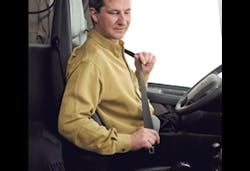LOUISVILLE, KY. DOT Secretary Norman Mineta and FMCSA Administrator Annette Sandberg headlined a driver-focused event here at the Mid-America Trucking Show today to kick off a renewed effort to increase seat-belt use among commercial drivers, as well as highlight other ways government and the trucking industry can improve their safety on the highway.
“You are the professionals, you are the knights of the road, you are literally moving the American economy,” Secretary Mineta said. “The trucking industry moved $6 trillion worth of goods last year from factories and farms to warehouses, stores, and doorsteps. But drivers never know what unexpected dangers might be around the corner as they perform their vital job. That’s why we want them to be ready and buckle up.”
Mineta said that while 80% of the American motoring public uses their seat belts, less than half of commercial truck drivers do. He pointed to grim statistics to illustrate the consequences of not wearing seat belts. Of the 620 truck drivers killed in 2003, half were not wearing their seat belts, and of the 171 ejected from their truck cabs, over 80% were unbuckled.
“Far too many truck drivers take it on faith that the size and weight of their rigs will protect them and that if they are a really good driver, they don’t need to wear a seat belt,” he added. “But driving unbuckled is like playing Russian roulette – you are tempting fate, because you never know when the loaded chamber will come around.”
Administrator Sandberg noted that other safety efforts are being initiated to better protect commercial truck drivers, most notably several pilot programs to enforce better behavior on the part of passenger-car drivers.
“We’re working on a pilot program [in Washington state] where we’re putting state troopers in the truck cab to watch for car drivers that cut truckers off and thus reduce the safe following distance truck drivers need to maintain,” she said, to a huge round of applause from the attending owner-operators and company drivers. “Those troopers in the truck then call ahead to other officers who pull those car drivers over and issue them citations.”
Jim Johnston, president & CEO of the Owner-Operator Independent Drivers Assn. (OOIDA), applauded the DOT and FMCSA effort to use a campaign of education and persuasion to get drivers to use their seat belts instead of intimidation and enforcement, but stressed that tighter driver training requirements are needed to really boost highway safety.
“We need to strengthen commercial driver training and focus, too, not just on bad drivers but bad carriers,” he said. “Bad carriers are the ones that are putting poorly trained drivers out on the road in the first place.”
Steve Williams, president of steel hauler Maverick Transportation and chairman of the American Trucking Assns., added that drivers themselves have to help enforce better safety on the road with their peers.
“We’ve taken a lot of flack on safety and there’s a lot we deserve,” he said. “The lion’s share of drivers out there are true knights of the road, but the bad operators average us down. I don’t make excuses for bad operators and if a driver sees something going on out there they have to call attention to it. We have to pull ourselves up if we want to reclaim the proud ground we once had.”
About the Author
Sean Kilcarr
Editor in Chief
Sean Kilcarr is a former longtime FleetOwner senior editor who wrote for the publication from 2000 to 2018. He served as editor-in-chief from 2017 to 2018.
